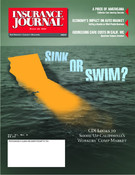Have we finally arrived at the point where the economy is a critical factor in personal automobile insurance?
Not quite but it is my opinion that we are closing in. Although insurance company annual statements do not discern between the various tiers of personal automobile insurance, i.e., superior, preferred, standard, sub-standard, etc., my hunch is that the economy is beginning to influence the sub-standard automobile insurance marketplace. If my theory is correct, then policyholders in California may be adversely impacted.
Some analysis of historical personal automobile insurance prior to discussing my theory …
In California, over the period from 1998 through 2001, the top three writers in the state – State Farm Mutual, Farmers Insurance Exchange and California State Auto Association-Inter Insurance- wrote 38 percent of the personal automobile insurance in California. Their market share decreased to 33 percent by 2001. However, the top 25 writers had a stagnant market share of 81 percent, for 2001 versus 1998. The top three saw their calendar year loss ratios increase from 61 percent in 1998 to 70 percent in 2001.
Although year-end 2002 data will show premium increases were put in place, the fundamental question is whether or not loss ratios will decline.
Back to my theory, consider the following:
According to the Federal Trade Commission’s Web site, credit scoring is a system that creditors use to help determine whether to give individuals credit. The FTC site goes on to state that information about individuals and their credit experiences, such as bill-paying history, the number and type of accounts they have, late payments, collection actions, outstanding debt and the age of their accounts is collected from one’s credit application and their credit report. A credit scoring system awards points for each factor that helps to predict how creditworthy a person is.
| Premiums & Losses in the California Private Passenger Auto Market | |||||||||||||||||||||||||||||||||||||||||||||||||||||||||||||||||||||||||||||||||||||||||||||||||||||||||||||||||||||||||||||||||||||||||||||||||||||||||||||||||||||||||||||||||||||||||||||||||||||||||||||||||||||||||||||||||||||||||||
|
|||||||||||||||||||||||||||||||||||||||||||||||||||||||||||||||||||||||||||||||||||||||||||||||||||||||||||||||||||||||||||||||||||||||||||||||||||||||||||||||||||||||||||||||||||||||||||||||||||||||||||||||||||||||||||||||||||||||||||
| * Auto Physical Damage is not separated into Personal and Commercial in the NAIC quarterly statement. * Rankings based upon California Private Passenger Auto Liability and Physical Damage Combined Direct Written Premium for 2001. * Data from Exhibit of Premiums and Losses (page 24 in the annual statement) represents calendar year experience for P&C insurers reporting data to the National Association of Insurance Commissioners.>br>* Quarterly data from Part 1 and Part 2 represents year to date calendar year experience for P&C insurers reporting data to the National Association of Insurance Commissioners. Developed by Demotech, Inc., Columbus, Ohio from Thomson Financial Insurance Solutions data. |
|||||||||||||||||||||||||||||||||||||||||||||||||||||||||||||||||||||||||||||||||||||||||||||||||||||||||||||||||||||||||||||||||||||||||||||||||||||||||||||||||||||||||||||||||||||||||||||||||||||||||||||||||||||||||||||||||||||||||||
| Premiums & Losses in the California Private Passenger Auto Market | |||||||||||||||||||||||||||||||||||||||||||||||||||||||||||||||||||||||||||||||||||||||||||||||||||||||||||||||||||||||||||||||||||||||||||||||||||||||||||||||||||||||||||||||||||||||||||||||||||||||||||||||||||||||||||||||||||||||||||
|
|||||||||||||||||||||||||||||||||||||||||||||||||||||||||||||||||||||||||||||||||||||||||||||||||||||||||||||||||||||||||||||||||||||||||||||||||||||||||||||||||||||||||||||||||||||||||||||||||||||||||||||||||||||||||||||||||||||||||||
| * Auto Physical Damage is not separated into Personal and Commercial in the NAIC quarterly statement. * Rankings based upon California Private Passenger Auto Liability and Physical Damage Combined Direct Written Premium for 2001. * Data from Exhibit of Premiums and Losses (page 24 in the annual statement) represents calendar year experience for P&C insurers reporting data to the National Association of Insurance Commissioners. * Quarterly data from Part 1 and Part 2 represents year to date calendar year experience for P&C insurers reporting data to the National Association of Insurance Commissioners. Developed by Demotech, Inc., Columbus, Ohio from Thomson Financial Insurance Solutions data. |
|||||||||||||||||||||||||||||||||||||||||||||||||||||||||||||||||||||||||||||||||||||||||||||||||||||||||||||||||||||||||||||||||||||||||||||||||||||||||||||||||||||||||||||||||||||||||||||||||||||||||||||||||||||||||||||||||||||||||||
As insurance companies begin to phase credit scoring into their underwriting process, drivers may be classified as sub-standard because of their credit scores. In this situation, an automobile insurance premium can be based on the score assigned by a credit-scoring model. Residents of states that have below average homeownership rates and therefore may not own a home may be adversely impacted.
Homeownership is a measure of financial stability and a measure of residence stability. For decades, these are two critical factors that personal automobile insurance company underwriters have evaluated.
Consider this; the United States Census Bureau recently published its annual statistics on housing vacancies and homeownership. California has a 58.0 percent homeownership rate. The comparable national average is 67.9 percent. Are the credit scores of California residents being unduly impacted because residents do not own homes?
If a credit-scoring model assigns a favorable weight to homeownership, then it seems reasonable to assume that the credit scores in states with lower homeownership rates would be lower than the credit scores in states with higher homeownership rates. In contrast, Indiana’s homeownership rate for 2002 was 74.2 percent Minnesota was 75.4 percent.
In an uncertain economy, the economics of unemployment can hurt individuals twice. First, they suffer a loss in income because their unemployment benefits are less than their previous income. Second, when one’s credit score is lower, higher insurance premiums cut even further into a person’s buying power.
The California Department of Insurance has been at the forefront of consumer protection. Accordingly, they are at the forefront of the analysis of credit scoring models and the application of credit scoring models to consumers of insurance. Concurrent with lower homeownership rates seems to be a relatively high cost of living or relatively high unemployment. Further, large and geographically diverse states, such as California tend to have population clusters. These cities may have sections of the city that have above incidences of car theft and other crimes.
While it seems reasonable to require garaging of a vehicle for the vehicle to be eligible for insurance at a preferred premium; a garage might also be considered a surrogate for homeownership. When homeownership rates are lower than average, it seems to me the likelihood of having access to a garage is lower than average.
The companies that develop credit-scoring models are adamant that their models and the inner workings of their models are proprietary information. Their argument is that they have invested in the development of that model and they have verified the predictive ability of their model. Faced with this dilemma, sophisticated departments of insurance must balance their consumer protection oversight with the realities of the business community. Is it possible for a regulator to assess the objectivity of a credit scoring model without breaking open the black box?
The flip side of this discussion is that credit scoring helps some consumers save money.
Consumers with better than average credit scores are eligible for preferred rates. Where does an insurance department draw the line on the evaluation of credit scoring? It seems to me that credit scoring may become the New Millennium’s equivalent of redlining.
Independent agents should know how their markets utilize credit scoring.
Most consumers will accept the correlation between their driving record and the cost of their insurance; however, when they are quoted a higher premium, the correlation of a credit-scoring model versus their potential loss experience may be too subtle to accept. If an applicant has a relatively clean driving record yet pays a standard or non-standard premium, the applicant may be critical of the process.
If you have access to markets that do not utilize credit scoring, it may be time to become re-acquainted with their underwriting guidelines.
Joseph L. Petrelli is president, Demotech, Inc., Columbus, Ohio. For more information on the company, log onto www.demotech.com.
Topics California Carriers Auto Profit Loss Personal Auto Homeowners Property Casualty Ohio Casualty
Was this article valuable?
Here are more articles you may enjoy.


 Georgia Republicans Move to Scrap State Income Tax by 2032 Despite Concerns
Georgia Republicans Move to Scrap State Income Tax by 2032 Despite Concerns  New York State Police Report 37-Vehicle Pileup on I-81 Near Syracuse
New York State Police Report 37-Vehicle Pileup on I-81 Near Syracuse  Alliant Latest to Sue Howden US Over Alleged ‘Smash-and-Grab’ Poaching
Alliant Latest to Sue Howden US Over Alleged ‘Smash-and-Grab’ Poaching  Warburg Mulls $1 Billion Sale of London Insurance Broker McGill
Warburg Mulls $1 Billion Sale of London Insurance Broker McGill 



